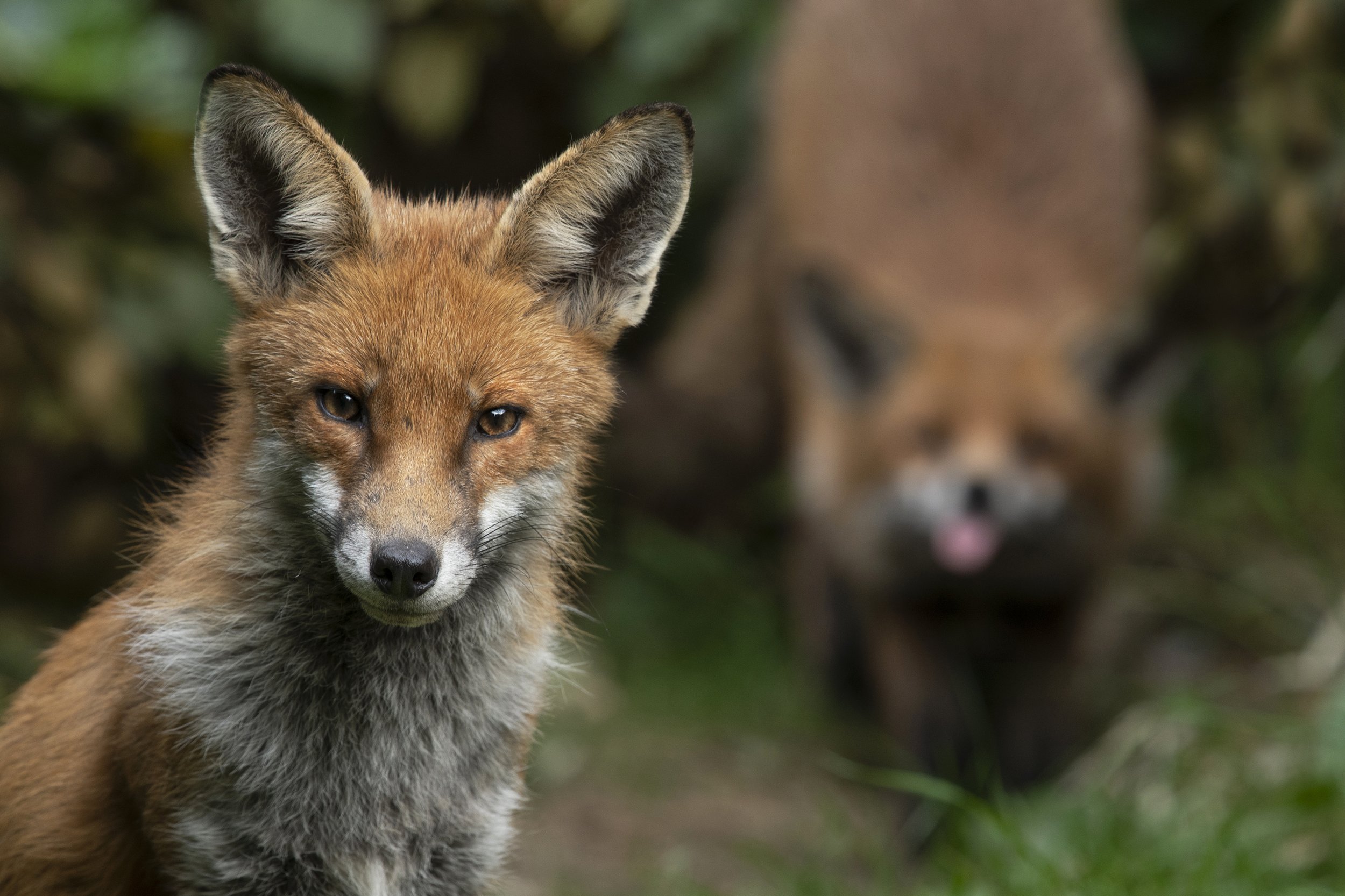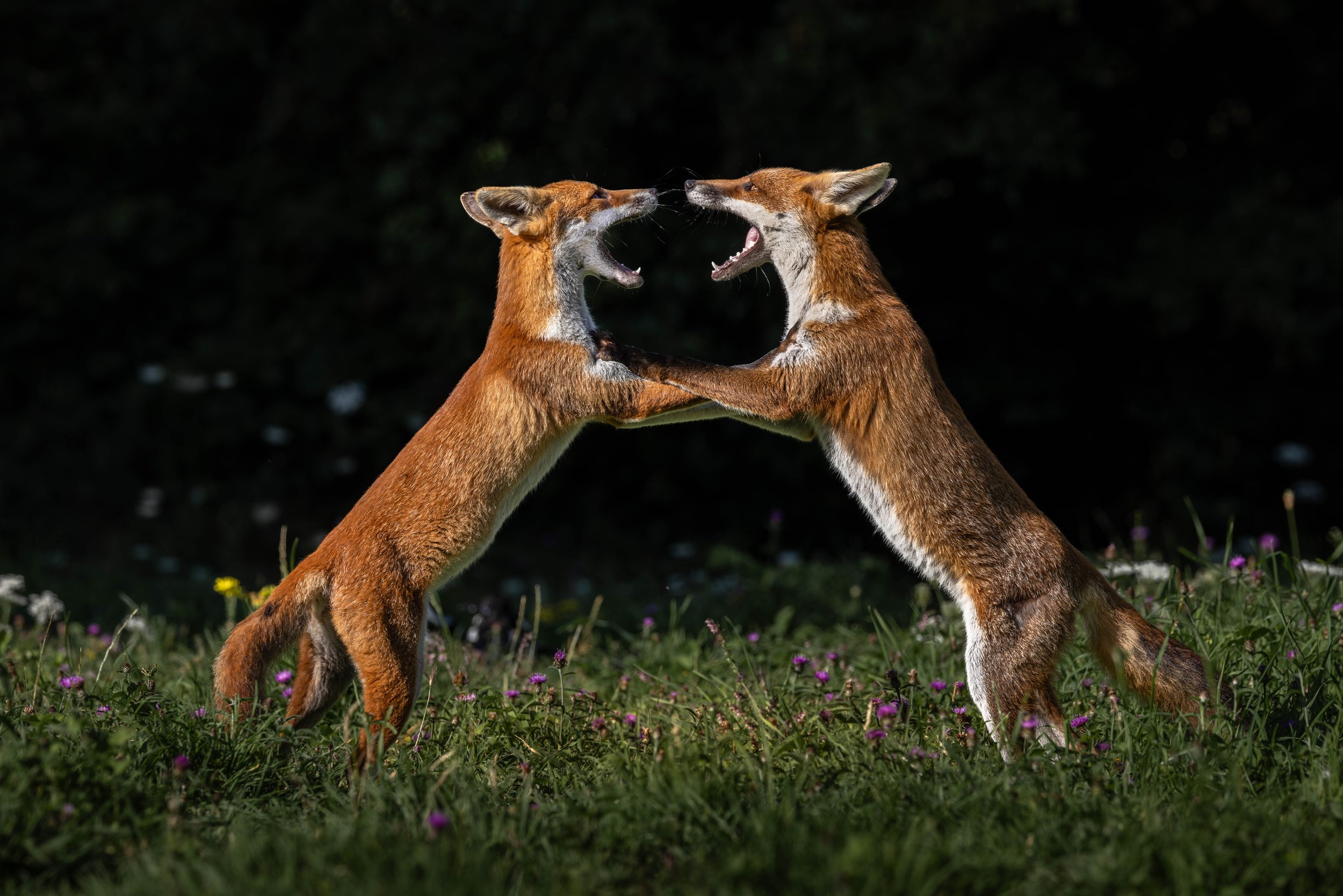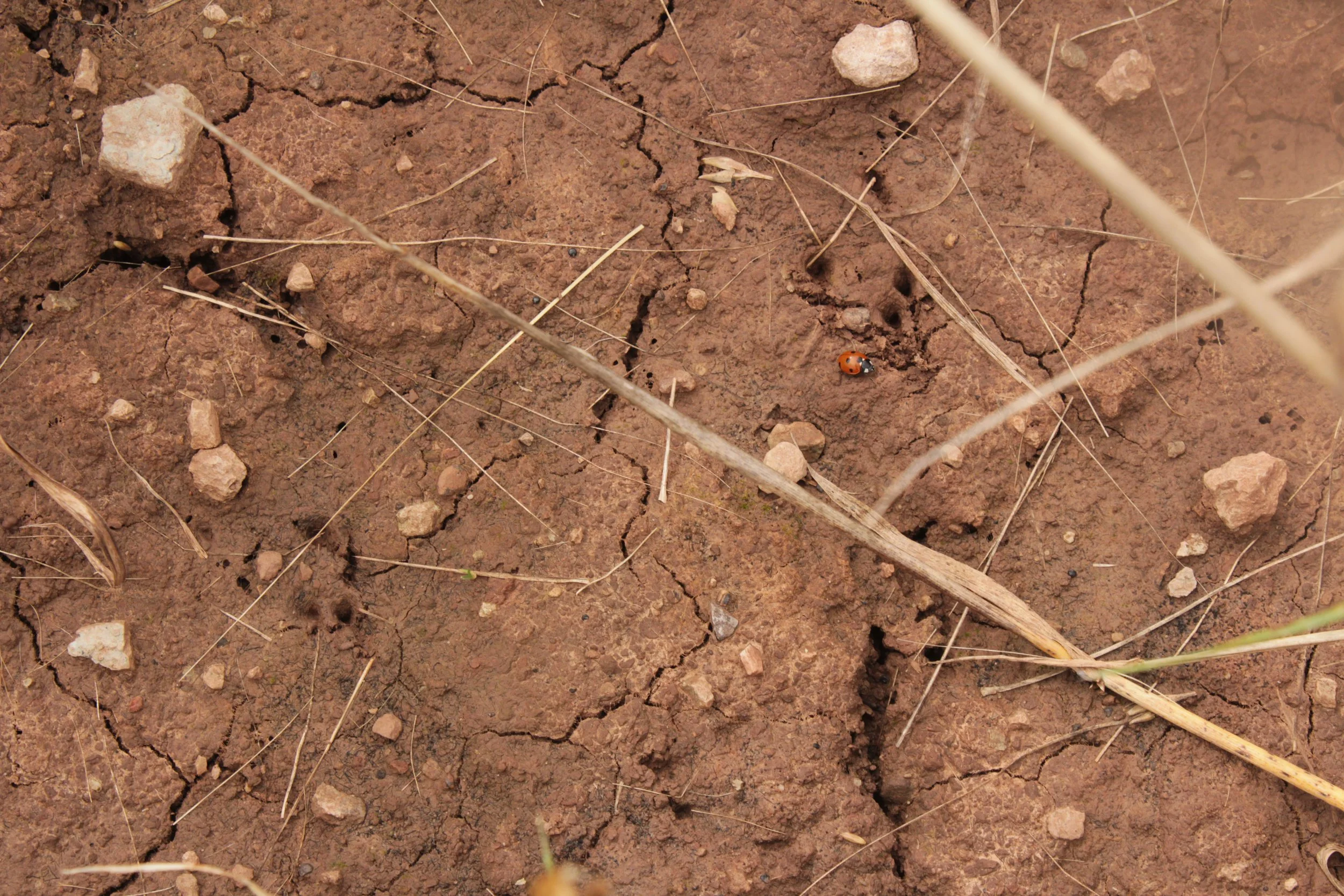Red fox
Scientific name: Vulpes vulpes
“A fox is subtlety itself.
- Aristophanes
These highly adaptable survivors can be found in all kinds of habitat, from wetlands to mountains and cities to farmland – no matter where you live, almost everyone in Britain has encountered a wild red fox. If you haven’t seen one, you may have heard its characteristic ‘scream’; this mating call is often mistaken for a human in distress!
Taxonomy chart
Animalia - Chordata - Mammalia - Carnivora - Canidae - Vulpes - V. vulpes
Conservation status: UK Red List
GB: Least Concern
England: Least Concern
Scotland: Near Threatened
Wales: Least Concern
Global: Least Concern
Summary
Diet: Omnivorous, from crabs to blackberries, with a mainstay of mice, voles, and rabbits – foxes will change their diet in response to their habitat, eating crabs and seabirds in coastal regions and small mammals, invertebrates, birds and blackberries in rural habitat as well as scavenge on human food waste.
Habitat: Everywhere! Known to frequent almost all habitat types in the UK, including woodland, urban and suburban areas, mountains and wetlands, though they need plenty of cover (whether hedgerows, shrubberies or woodland foliage) and somewhere they can dig an earth.
Size: Variable; males average between 67-72cm in length and 6-7kg in weight, while females average between 62-67cm and 5-6kg. Length measurements exclude the tail, which measures approximately 40cm on average.
Lifecycle: The oldest confirmed wild red fox was an ear-tagged female from the Netherlands, who died aged 12 years. Individuals have been estimated at 11-15 years old based on tooth wear, but 1-3 years is the average lifespan for a wild fox. The young, known as cubs, are born in the spring, with births peaking in mid-March.
Conservation Concerns: Fox populations in the UK are currently stable, although data on population trends are conflicting and some populations are declining. Their only legal protection is from hunting with dogs, and they are often controlled by land owners/managers via shooting to protect livestock and game birds. They have been hunted historically both for sport and as part of the fur trade. Potential causes of current declines are unknown but appear to coincide with significant declines in rabbits across England, Scotland and Wales. Previous declines have been the result of hunting and outbreaks of mange.
Terminology
Habituation: The process of becoming accustomed to something; used in conservation to refer to animals that have lost their fear of humans.
Generalist: In biology, a highly adaptable animal that is able to survive in a diverse range of conditions and habitat types and utilises a wide variety of resources.
Opportunist: In biology, a species that is quick to take advantage of new resources or habitats.
Crepuscular: Active at dawn and dusk; as opposed to nocturnal (active at night) and diurnal (during the day).
Binocular vision: Vision that uses two eyes with overlapping fields of view to allow for a good perception of depth.
Cub: A young fox.
Vixen: A female fox.
Geography
The red fox is both the most widely distributed and the most common free-living carnivore seen in cities, and as such can be found throughout most of the British Isles, excluding all Scottish islands except Skye and Harris. While they are known to spend time in cities across their global range, in comparison to their European counterparts, British foxes are particularly renowned for their adaptation to urban environments.
They can be found in a wide variety of habitats, including urban and suburban areas, gardens, amenity parkland, rivers and wetland, coastal areas, marshland, deciduous and mixed woodland, arable land and even mountains. Despite this, they are most likely to be seen in urban or suburban areas, as they can quickly become habituated to human presence. While foxes will frequent fully urban areas, radio-tracked foxes in Bristol spent more time in and covered the most distance across back gardens, woodland, allotments and rough ground.
Biology
The red fox is similar in size to a small dog. It is the second largest carnivore in Britain, after the European badger. The reddish-brown coat, dark legs and white tail tip make this species easily distinguishable from other native species or domestic dogs, and they are also one of our most commonly encountered mammals. Their size is variable, and females are typically smaller than males; an average male will measure between 67-72cm and length, excluding tail, and weigh between 6-7kg, while an average female will measure between 62-67cm, and weigh approximately 5-6kg. The tail is, on average, 40cm long.
Red foxes have pointed muzzles with large ears, and amber, forward-facing eyes. Their hearing is highly acute, and they are particularly attuned to low-frequency sounds. Like us, they have binocular vision, although as a predominantly crepuscular species, they are good at seeing in low-light conditions. Their fur is reddish orange, with white fur on the muzzle, legs and belly and black on the legs and the backs of the ears. The tail is long and bushy with a white tip, and may make up as much as 40% of the fox’s total length. Observation of foxes hunting in deep snow in Europe has suggested that they may be able to make use of magnetic fields, with jumping attacks proving most successful when the foxes faced a north-easterly direction. The mechanism through which they do this is unknown, although while the link is not confirmed, it has been suggested that this might be facilitated by a protein in the eye called cryptochrome 1.
Red fox family groups will usually consist of a male-female pair and their cubs, but in areas with plentiful food and low levels of persecution, these group sizes might expand to include several adults. Their territory size will be highly dependent on habitat type and food availability, varying from 0.2 square kilometres in urban areas to 40 square kilometres in upland habitats where food is scarce. Even in larger family groups, only one vixen will typically produce cubs in a year. Mating begins in January and is accompanied by characteristic ‘screaming’ calls, with litters born in the spring and births peaking in the middle of March. Young are called cubs, and an average of four to five will be born blind and deaf, weighing between 70 and 120g. They will remain in the den, called an earth, for four weeks; some earths are dug by foxes for this purpose, but they will use holes made by other animals and enlarge these where necessary. In urban areas, they will even dig earths under garden sheds. The mother will remain with her cubs for the first two weeks of their lives, and two weeks after this, in late April or early May, cubs will begin to leave the den, and the weaning process begins. They are fully grown by six months, spending most of the spring and summer playing with their littermates to develop vital hunting, fighting and survival skills for the future.
Ecology
Red foxes are generalist omnivores and highly opportunistic, adjusting their diet to better fit the environment they live in. In salt marshes and coastal regions, they’re known to eat crabs and scavenge dead seabirds. In lowland rural areas, their diet encompasses small birds and mammals, invertebrates and berries, while in mountainous regions where food is scarce, they are thought to be more reliant on carrion. Urban fox diets are often supplemented by local householders, but they will also scavenge from bird feeders, dustbins and compost heaps, and hunt feral pigeons and small birds.
The relative abundance of red foxes in the UK is in part linked to their status as a mesopredator, a species that sits just below the apex predators in a food chain. When the apex predators are removed from an ecosystem, mesopredator populations tend to increase due to decreased competition and predation – an effect known as ‘mesopredator release’. The extinction of apex predators like wolves and lynx in the UK has led to increased mesopredator populations, likely compounded in the fox by favourable foraging landscapes and intentional feeding by humans. However, foxes are also important predators in their own right, controlling small mammal and rabbit populations. As omnivores, they also play a role in seed dispersal, and in scavenging they provide a beneficial service in carrion removal.
Conservation
Data on population trends are conflicting, with some records suggesting that there was an increase in foxes in the 1960s, followed by a period of stabilisation between the 1990s and 2009. Data from Breeding Bird Survey sites suggests there may have been a decline of up to 41% in these areas, but in the 2010s, foxes were recorded in 90% of 65 cities where they had previously been rare or absent. Overall, however, they are considered to be Least Concern through the UK with the exception of Scotland, where they are listed as Near Threatened.
Foxes have been hunted historically for fur and for sport, although sport hunting with dogs is now illegal across Britain; the Hunting Act 2004 outlawed hunting with dogs in England and Wales, while the Hunting with Dogs (Scotland) Act 2023 now outlaws this in Scotland. They are not protected from all shooting and are often culled as a pest species in rural areas. As an omnivorous and opportunistic feeder, localised population increases as a result of countryside management practises can become a concern to other native species. In particular, foxes are known to eat the eggs and chicks of ground-nesting birds, and lethal population control has been proposed to tackle declines of species like the curlew.
There may also be health concerns associated with foxes living in urban environments. A study of 18 samples at the University of Wolverhampton found that urban fox scat contained 135 dangerous artificial chemicals from 17 of the scats, including some which have likely originated from consumption of discarded cigarette ends and petrol.
History
The oldest red fox fossils are between 1 million and 500,000 years old, and this likely represents the time the species began to diversify in Eurasia. From here, dispersing red foxes would spread to Japan and North America, with multiple colonization events occurring through the mid to late Pleistocene. At this time, red fox fossils have also been found in association with archaeological human remains in Europe, suggesting that even then there was some anthropogenic influence on their lifestyle. At some point before the last Pleistocene glaciation, central European foxes dispersed to mainland Britain, becoming isolated around 8,200 years ago. Although some foxes in southern England are more closely related to French populations than other English foxes, genetic data shows that this mixing occurred long after the formation of the English Channel, and this is most likely to be the result of nineteenth century translocations for sport hunting. It has also been proposed that humans may have brought red foxes to Ireland, but the possibility of a natural Irish colonization from the UK mainland across glacial land bridges has not been ruled out.
Foxes have a rich folkloric history across the world, including the Japanese kitsune and the Finnish revontulet – a word for the aurora borealis, associated with the Arctic fox, which in legend is believed to be the force behind the northern lights. In many countries, including Britain, they have become symbolic of cunning, trickery and cleverness. The character of Reynard the fox originated in medieval European stories, but gained popularity in Britain in 1841 when William Caxton first translated the tales from Middle Dutch. Reynard, also spelled Renard, was a trickster character known for his rebellious and mischievous nature, and his name is derived from the German raginhard - meaning brave.
From this, Reynard became a common nickname for a fox in rural Britain. They would also be referred to as Tod from 1912 onwards, when Beatrix Potter’s ‘The Tale of Mr Tod’ was published, telling the story of a fox and his badger nemesis, Tommy Brock. In 1970, Roald Dahl published ‘Fantastic Mr Fox’, which again portrayed a trickster fox character’s attempt to outwit the farmers he is stealing from. Foxes have remained prevalent in the English language today, through words like foxy, which may refer to fox-like characteristics or, alternatively, an attractive person, and outfox – to beat someone through cunning. It’s even thought that the word shenanigan might originate from the Irish sionnachuighim – ‘to play the fox’.
The history of hunting with dogs goes all the way back to ancient Egypt, but the specific custom of fox hunting is thought to have originated in Norfolk in 1534. Despite their lively appearances in British folklore, they are seen as pests in rural areas, and even now that fox hunting has been outlawed, they have little legal protection. Fox hunting remained popular through the seventeenth and eighteenth centuries, and in 1753 Hugo Meynell developed the modern fox hunting system while selectively breeding hunting dogs for speed, stamina and sense of smell. From 1934 onwards, hunting was banned across most European countries, but the practice was only made illegal in Britain in 2004. Despite this, fox hunts are still thought to take place every year, and it remains an emotive and controversial topic for the British public today.
Identifying and surveying
Field Signs: Fox scat is identified primarily by its pungent smell and diverse contents, which may change depending on the time of year or location. The droppings are usually twisted, with a tapering end, and will contain fur, bone fragments, fruit pips and insect casings. This distinguishes the scat from dog droppings; it may also be possible to confuse fox and hedgehog scat, but hedgehog scat will be smaller, blunt-ended and only contain invertebrate remains. Fox scat size is variable, but 2cm in width and 8-12cm in length is typical.
Fox presence can also be evidenced by footprints, but these can look similar to domestic dog prints. Fox prints are approximately 3.5cm wide and 5cm and long, with four visible toes, and can be confidently distinguished from dog or cat prints by drawing a diagonal cross over the print – if the lines don’t touch any of the toe pads, it’s a fox.
Earths: A fox’s den is called an earth, and these may be used year-round but tend to be most active in the spring, when cubs are born. The burrows tend to be taller than they are round, and measure approximately 20cm in diameter. An earth will consist of a few tunnels, with spoil heaps outside and the remains of fresh food between April and June, when cubs are present.
Survey Period: Foxes are active year-round but most likely to be seen in the early morning or late evening, particularly in rural areas.
Recommended reading
Foxes Unearthed – Lucy Jones
Potential repeal of the ban on hunting with dogs in Britain – Mammal Society Position Statement (https://mammal.org.uk/position-statements/potential-repeal-of-the-ban-on-hunting-with-dogs-in-britain))
The Red Fox – Mooney Goes Wild (https://www.rte.ie/radio/radio1/clips/22485707/)
Wild (Netflix documentary – Dutch with English subtitles available)
The Secret Life of Foxes – Chloe Petrylak
The Hidden World of the Fox – Adele Brand
Media content analysis of wild red foxes in the UK – Mammal Society Student Spotlight (https://mammal.org.uk/blog/2023/08/media-content-analysis-of-wild-red-foxes)
The Fantastic Urban Fox – Mammal Society On-Demand Webinar (https://mammal.org.uk/on-demand-learning-library/p/the-fantastic-urban-fox)
Frequently asked questions
-
Although they can sound eerily like a human in distress, foxes ‘scream’ to communicate with each other. The sound is most commonly heard in January, when it often functions as a mating call, but ‘screams’ may also be used to mark territory, defend cubs and threaten competitors.
-
While some fox species, like the grey fox, spend a large proportion of their time in the trees, red foxes are rarely, if ever, observed climbing and are not adept climbers.
-
Like all canids, including dogs, chocolate is toxic to foxes. Urban foxes are not picky about their food and will readily eat scraps left behind by humans, but feeding foxes is not advised – even if the food itself isn’t harmful, it can encourage habituation.
-
The risk of cats being attacked by foxes is very low – while 541 out of 10,000 cat admissions had been injured in a fight with another cat, just 14 out of 10,000 were admitted following an altercation with a fox. Road accidents and injuries from dogs or humans are also far more common than fox attacks.
-
Foxes are primarily crepuscular or nocturnal. Being active during the day can be a sign of illness, but daylight activity has become more common, especially in urban and residential areas where foxes may have become habituated to people.
Confusion species
Domestic dog (Canis lupus familiaris)
The domestic dog is the only native species in the UK that could possibly be confused with a red fox, but the colouration and markings of the fox should easily distinguish it from a domestic dog. The fox has reddish-orange fur with a white tail tip, belly and neck, brown or black legs and a very bushy tail. The ears are large and pointed, and the head is slim and pointed.
Identify sounds
Heard a curious animal sound but no idea whose making it?
Wildlife identification FAQ
Still not sure what you’ve found? Head over to our FAQ for an answer.








